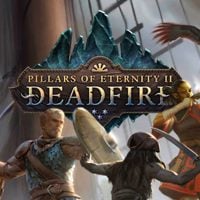Pillars of Eternity 2: Beginner's Guide
This page of the guide features answers to all the most basic questions related to Pillars of Eternity 2 Deadfire, primarily aimed towards new players. We've discussed other topics related to the game on separate pages of this guide.
- Difficulty level - which one should I choose for my first playthrough?
- How to import your progress from Pillars of Eternity 1
- Hero and party - how to plan out your game?
- Auto-Pause - when to use it?
- XP - how to level up faster?
- Stealth - advantages of remaining in shadows
- Traveling around the world - local and world maps
- Items that are useful during exploration of the world
- Quests - the game doesn t show you an exact path to goal
- Positive and negative status effects - how to understand them?
- Saving the game and a character s death
- Party assist rolls - ability points of your entire party can combine
Difficulty level - which one should I choose for my first playthrough?
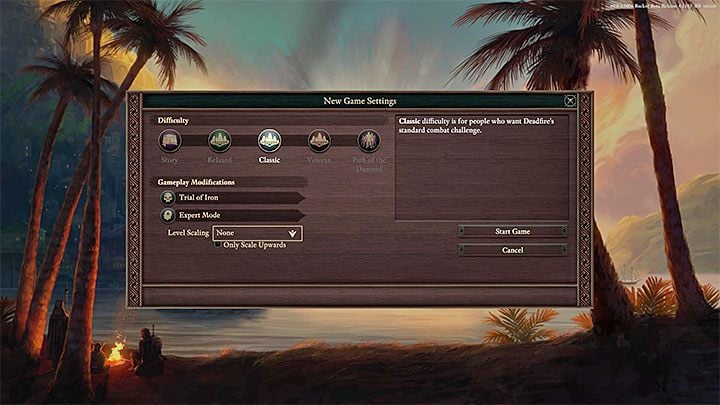
The Classic difficulty level is the best choice for your first playthrough. Here, you have to prepare your party for the majority of encounters with monsters or to deal with their unusual attacks but, unlike the next levels, it doesn't offer a huge challenge. This difficulty is forgiving to all smaller "mistakes" done while you are choosing your party members or those made during the process of developing your character. The exception to that is when you haven't played the first game or you don't remember it very well. If so, then think about choosing Relaxed difficulty level, at least for the first few hours of the campaign.
The ability to change your current difficulty level at any point is an important feature of Pillars of Eternity 2 Deadfire. This option is useful when, e.g. you can't win a fight despite numerous attempts. The difficulty can be changed in the options menu. Remember that these changes affect only a challenge offered by enemies spawned on the currently explored map. Other changes, e.g. number of enemies, are activated on new maps. Note - Changing your difficulty level right after starting the game can block access to some of the achievements!
More information about the difficulty levels can be found on Choosing the difficulty level page.
How to import your progress from Pillars of Eternity 1

Pillars of Eternity 2: Deadfire allows you to import your choices from the first installment and its White March mission packs. There are as many as three ways to do that:
- Import a savegame from Pillars of Eternity 1 - This is the best solution, if only you have your saves from the previous installment and you want the game world in the second installment to reflect those choices.
- Use one of the six Histories (the above screenshot) - This one is the best solution if you do not have any saves, or you simply want to make a quick start. It is best to pick one of the more neutral variants. The most extreme is the sixth History, because it it assumes the worst of possible scenarios (choosing "bad" quest endings; causing the death of your party members, etc.). Do not pick this one if this is your first time with Deadfire.
- Write your own story - You can do that in the main menu. There are many options to pick from and they can, e.g. determine how important quests ended, whom you have helped, who died, what has become of the remaining party members, etc. This is a good solution if you have played the first installment, but you do not have any saves.
Additional note - all events or dialogue options resulting from choices made in Pillars of Eternity 1 are marked with special icon (a Roman numeral with blue backdrop).
Hero and party - how to plan out your game?
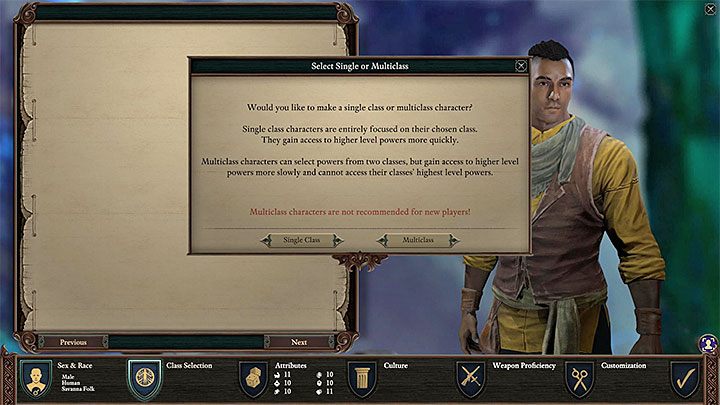
The character creation process is incredibly important in Pillars of Eternity 2 Deadfire. Creating a weak or a difficult to manage character can add to the difficulty level. Decide whether you want to play as a single or multi class character during your first playthrough. A multiclass character offers a greater variety and options but it is also easier to make mistakes that can make your character weaker. If you have played the first Pillars of Eternity then you can think about creating a multiclass character but try to pick less complicated classes (e.g. fighter + ranger) which are easy to develop. If this is your first time with the series then making a single class character is your best choice. Thanks to that it will be easier for you to make decisions while leveling up and choosing new skills or stats.
Choosing your party members is equally important. Your party in Pillars of Eternity 2 Deadfire can only consist of five characters (the first game allowed players to have six party members). This is one of the reasons why playing a multiclass character is so attractive. Having only single class characters gives you less options. After you have encountered a potential party member, you can pick their class (the game proposes two regular classes and a single item for a multiclass character). Try to have a party where the main classes (fighter, mage, priest, ranger etc.) have at least one representative. Other decisions, such as whether you want to fight in close-combat or to use spells, are up to you.
The most important information about creating a character and managing your party can be found in Character progress and Party chapters.
Auto-Pause - when to use it?
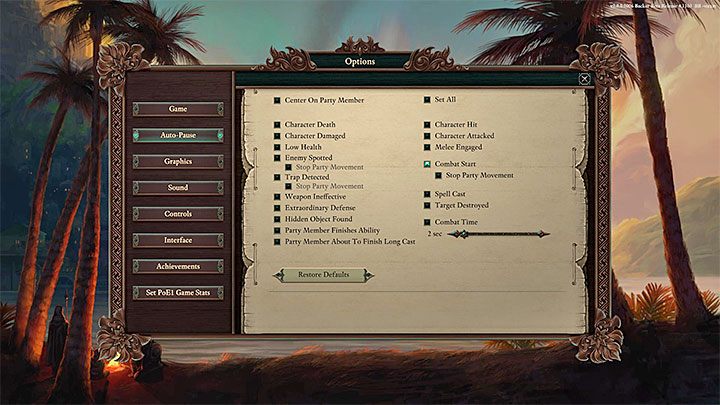
Pause is an integral part of almost every battle in Pillars of Eternity 2 Deadfire. This element should be familiar to you if you have played the first game or any other classic RPGs. Using auto-pause is equally important - it activates automatically upon meeting certain conditions. Auto-pause can be adjusted in the options (the picture above). The recommended settings for activating auto-pause are:
- Enemy spotted. This is almost a must-have. Auto-pause can protect you from running between enemies and a necessity of making a few quick reactions. Also, this option is useful if you play as a stealth character because you can start planning your sneak attack sooner (or you can decide to go around a tougher enemy). Note - Remember to set Stop Party Movement if you decide to use this option and the following two. This lowers a chance of having one of your companions running into grave danger.
- Combat start. This is an extension of the option described above. Even if you don't need to make additional preparations for a particular fight, there are still situations (e.g. an enemy sneak attack or a conversation that ends with a fight) where this option is very useful.
- Trap detected. Another very important setting. You will find numerous traps throughout the game. Most of them can deplete your party member's health in a blink of an eye and they also can cause injuries. Important note - Not every trap can be automatically detected by your party. This depends on the Perception level. Watch out, especially inside of dungeons. You can try to zoom in as close as you can and examine newly visited rooms yourself - traps can usually be spotted with a naked eye (e.g. rows of small holes in a floor).
- Low health. This is a much better setting than the one where the game auto-pauses after a death of a party member (knocked on the ground). Restoring a health bar is much simpler than bringing back someone to life. Also, being knocked down causes injuries which make that character closer to permadeath.
- Hidden object found. Stashes are marked with purple. This setting is useful when you want to visit locations. Without it you can easily miss a message about coming across a hidden object, especially when the camera isn't centered on the party at that moment.
- Weapon ineffective. This and other, similar, settings are useful on higher difficulty levels since you will come across more enemies with partial or complete resistance to certain types of damage. These settings aren't required on lower difficulty levels but they can still help you in detecting problems faster.
Additional note - Apart from autopause, you can also use combat speed control system. This allows you, in a way, to slow down time to grant you more control over what is going on. As for easy fights, you can speed them up. To learn more, check the chapter entitled Combat.
XP - how to level up faster?
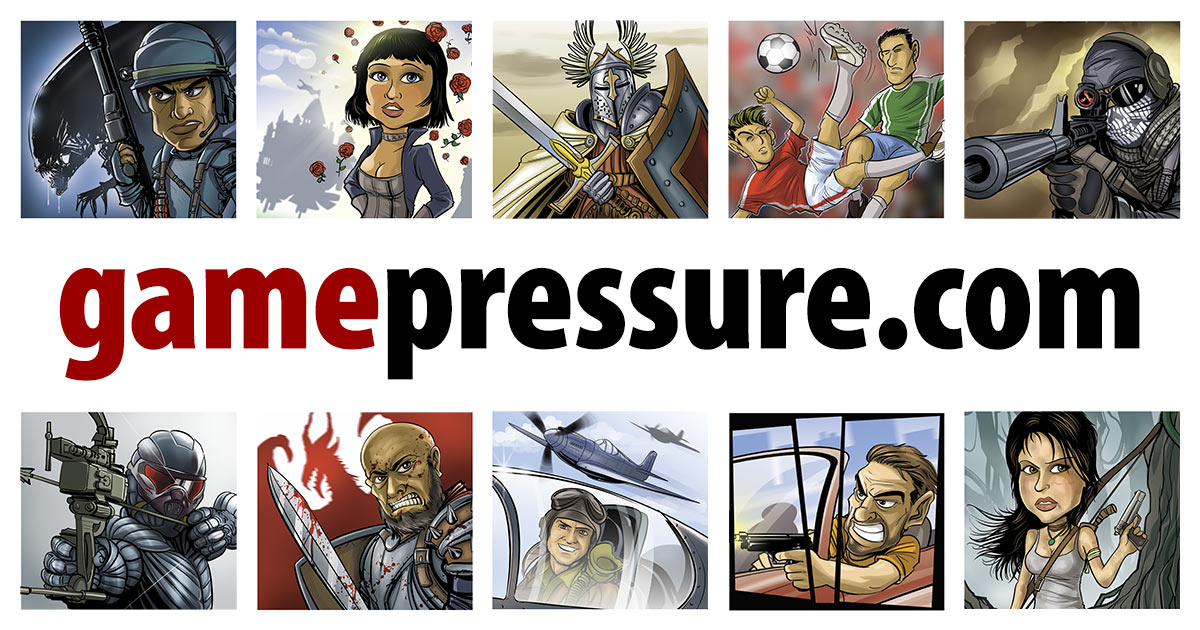
Completing main and side quests is the best source for XP in Pillars of Eternity 2 Deadfire. Try to unlock them all. You receive XP regardless of how a quest has been completed.
Other methods of getting XP are discovering new locations and adding new enemy entries to the bestiary. Important information is that in the case of battles with monsters, only those battles that involve adding a completely new entry to the bestiary or upgrading the already added entries are taken into account. In other cases (including fighting with people) you will not get any points.
More information about getting XP can be found on How to easily get XP? Page in the FAQ section.
Stealth - advantages of remaining in shadows
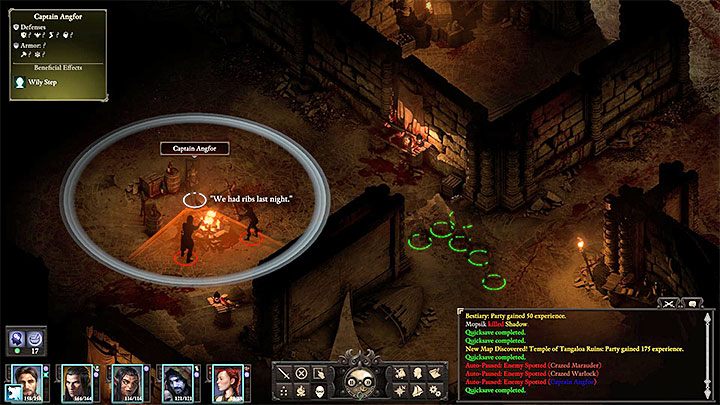
Relying on stealth in Pillars of Eternity 2 Deadfire is recommended - use it whenever you get a chance. The biggest advantages of sneaking are:
- The possibility of sneaking up on enemies which allows you to prepare your team better or to attack them by surprise (e.g. from a flank or from behind).
- A chance to go around stronger enemies. This is especially useful at the beginning of the campaign when your party can't deal with a few "elite" enemies at the same time.
- The possibility of stealing items from chests and pickpocketing. Both methods can give you valuable loot but remember to remain cautious - getting caught can reduce your reputation points in a given location and/or lead to a fight.
Stealth and Sleight of Hand (pickpocketing) are one of the abilities that you should start developing from the beginning of the game. You should also use help offered by the game - the grey circle which indicates how far a character can hear; the red triangle which shows an NPC's field of view, and small circles displayed on the ground around your characters which inform you how close they are to get detected.
Important note - Pillars of Eternity 2 uses a quite unique theft detection system. You neither will be caught, nor punished with negative reputation for breaking into a chest (even if you use lockpicks to do that). You can take a gander into a container and take a look at what's inside (and even read documents!), by clicking RMB. Only by taking an item out of the chest there is a risk of being caught. However, this only holds true for the items that have been marked red in the contents window.
More information can be found in Stealth and stealing chapter in our guide.
Traveling around the world - local and world maps
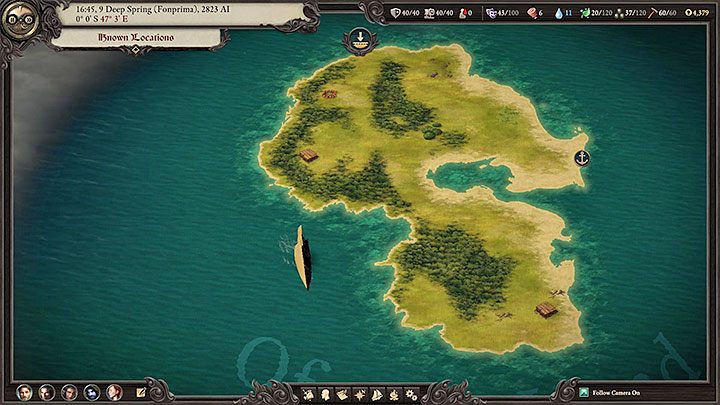
Travelling around the world of Pillars of Eternity 2 Deadfire is similar to the way it was done in the previous game. However, the sequel has a few new and important features. There are four aspects of traveling around the game world:
- Local maps - They include cities, villages, dungeons and other locations that have their own map and where you can see all your party members and the UI in its full version. Each local map has one or a few "exits" - they can lead to sublocations (e.g. dungeons beneath ruins) or to a city map/World map.
- Towns - larger locations in the game may be provided with city maps, where districts have been outlined (e.g. port, commercial). You can travel between those districts, where reaching another district usually takes up to 1-2 hours of in-game time.
- World maps: travelling on foot - This is how you discover new parts of the islands or other areas that are on land. You can freely select your destinations (time passes faster when you are travelling). Thanks to this method you can reach new locations on the maps or you can examine smaller locations (finding supplies, participating in a scripted interaction etc.).
- World maps: using a ship - This is a very important new feature added to the game. Using a ship is the only way to reach islands and other locations that are far away. The time passes faster and you can choose your direction, just like when you are travelling on foot. Thanks to your ship you can reach islands (look for docking icons), go straight into local maps but you also can examine optional locations. On top of that, your party can come across other ships - you can decide whether you want to attack them or avoid.
Save your game before you start examining a new area or an island. This can protect you from encounters with powerful opponents, a scripted interaction (which can be "failed" due to bad decisions) or a sea battle with an enemy ship. However, you shouldn't avoid exploring new places because visiting a new map for the first time gives you XP.
More information about exploring the world can be found in Exploration and interaction with environment and Travelling by ship chapters which contain numerous tips, e.g. on creating a ship crew, gathering supplies or defeating other ships in sea battles.
Items that are useful during exploration of the world
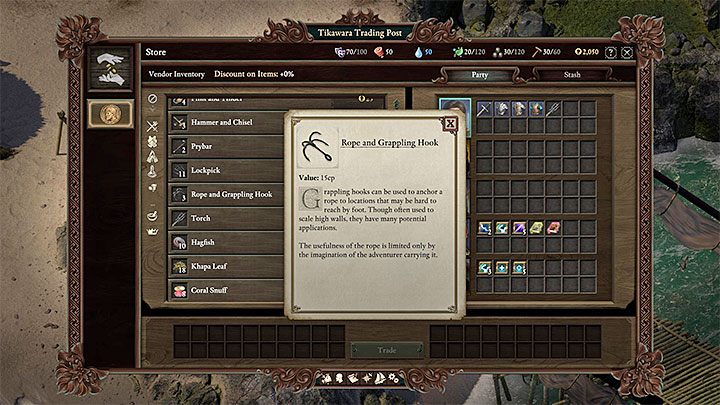
Using alternative passages, thanks to certain items, and reaching unique treasures was possible in the first Pillars of Eternity. Deadfire also has this option. One of the more important items are lockpicks. They allow you to open doors or chests, provided that Party Assist pool for Mechanics is slightly lower than that of a lock (e.g. a level 4 lock and 3 Party Assist points in Mechanics). Sadly, lockpicks can't be used when a lock's level is much higher than Mechanics level of the entire party. For example, lockpicks aren't available if a lock is at level 10 while your party has only 5 points in Mechanics.
Besides lockpicks, there are other items that offer unique interactions with environment (and potential new alternate passages). These items are Rope and Grappling Hook, Hammer and Chisel, Pickaxe and Prybar.
All of these items can be either bought from vendors or found in the world. Try to always have at least one unit of each item in your inventory. They are all single-use only. Save your game before using any of them in case an outcome wasn't satisfactory for you. When that happens, you can simply reload your previous save and leave that valuable "gadget" for later.
Quests - the game doesn t show you an exact path to goal
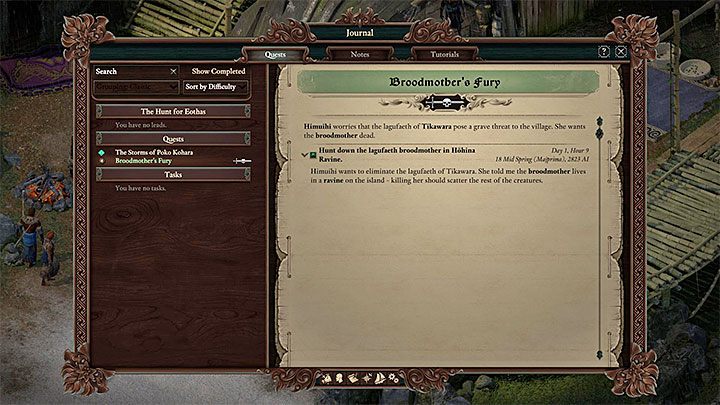
Just like in the previous instalment, Pillars of Eternity 2 Deadfire won't hold your hand throughout quests. Here you can find a few important information regarding quests:
- Speak with every NPC because quest givers aren't marked by the game. Look for characters with unique names, there is a big chance that you will be able to speak with them. Always remember to use all dialog lines (or at least use those that are available thanks to your current stats and party skills). Skipping a quest can lower your fun but it also costs you a lot of XP or items as rewards.
- Check your journal to read a description of every quest. The game doesn't mark any locations that are related to quests on the map (e.g. a cabin that can be examined, an NPC that can be interrogated). You have to discover all of this by yourself. Pay attention to bolded parts of text. They usually inform you about important locations or characters related to a given quest.
- Most of the quests in Pillars of Eternity 2 Deadfire aren't linear. This non-linearity is evident mainly in conversations with NPCs and interactions with environment objects. Some dialog lines or ways of behaving are only available when you meet certain requirements (e.g. a high Diplomacy or having a character from a certain race in your party). You may also need to make a choice - there are situations where certain actions are mutually excluding. Making a save before each important decision is a good idea. By doing that you get a chance to go back and pick a different line.
Note - The important piece of information, concerning quests, is that the game informs you about potential difficulty. This is represented by skulls in the journal next to the quest's name. The more skulls the more difficult the task. Leave all the most difficult quests for later time and focus on those that correspond your party's experience.
Our guide for Pillars of Eternity 2 Deadfire contains a walkthrough for the entire game. Check it if you have problems or doubts. We have tried our best to include as many variants as possible and to inform you about consequences of making certain actions.
Positive and negative status effects - how to understand them?

Statuses are an important gameplay element in Pillars of Eternity 2 Deadfire. They can determine how good (or bad) your party members are at fulfilling their orders. They can also affect their current health status. Statuses are divided into positive and negative. The positive ones are usually created by spells, blessings or effects caused by AOE attacks. Negative statuses can be caused by a unique attack or an activated trap.
Statuses are marked by small icons next to the portraits of your party members which are displayed in the bottom left corner. Move your mouse cursor over them to learn about a particular status. Negative statuses can be nullified by, e.g. drinking potions, antidotes or casting healing spells.
Many of the statuses last only a battle. Those, that last longer or are "permanent" (e.g. the status from the picture above which gives bonus stats if an animal companion is near that character) can be checked in the character sheet. Injuries are a separate category and they are marked with blood drops which are displayed next to a party member's portrait (on their left). More about them in the next subsection of this chapter.
Saving the game and a character s death

In default, Pillars of Eternity 2 Deadfire allows you to create an unlimited number of saves. You can use quick or manual saves. Also, the game always creates an autosave whenever you enter a new location. The exception to that is when you choose Trial of Iron modifier at the beginning of the game. In this mode you have to beat the game on a single save slot which gets deleted after death of your entire party. Don't try to play on this mode if you haven't completed the game at least once. This mode requires you to know everything about the game mechanics and to have knowledge about possible threats in a given location. Save your game before you start exploring an unfamiliar map or before each battle. Save BEFORE you get closer to enemies, that is before they notice your party.
In Pillars of Eternity 2 Deadfire, a party member that was knocked out won't die immediately. That character can be resurrected by another companion during the same fight or they will get up after a (victorious) battle. Sadly, you can't rely on this method whenever you want. Each situation where a character gets knocked down gives them an injury. Your current health status can be checked at any point of the game. These injuries are marked with red blood drops displayed on the left of a character's portrait - the character in the picture above has three injuries (three drops). The fourth drop means that this character will die permanently. Reloading a previous save is a good option here. However, injuries can be removed:
- Visiting an inn and renting a room is a better idea. Rest eliminates injuries and all other statuses, even if you use the basic variant (the one that doesn't give you any stats bonuses).
- An alternate way is to make a campsite. This method is only useful when you are away from a village or any other location that offers a resting place and your character has three injuries and is close to dying. Here, injuries can only be removed by using food.
Important note - Injuries can be caused not only during fights but also after stepping on a trap. Be very careful when you are examining unknown locations, especially dungeons. This will reduce a chance of activating a trap. Once you discover one, you can either try to disarm it or to go around it. Remember that high-quality traps may not be automatically discovered by your party. Perception is the attribute that determines how good your characters are at finding traps.
Party assist rolls - ability points of your entire party can combine

Pillars of Eternity 2 Deadfire features a system where abilities of your main character can be strengthened by the same abilities of other party members. How does it work in practice?
For example - the main character chooses an action that requires Diplomacy skill (this takes place during a conversation). Diplomacy skill of party members looks like this:
- Main character - 3 Diplomacy points
- Aloth - 4 Diplomacy points
- Xoti - 5 Diplomacy points
- Pallegina - 2 Diplomacy points
The main character has 3 Diplomacy points but they also receive a bonus from their party: 4 + 5 + 2 = 11. This gives additional 5 Diplomacy points - your character has 8 Diplomacy points when during this action.
The table below shows more dependencies:
Amount of points of a given skill from the entire party (without the main character) | Bonus skill points for the main character |
1 | +1 |
2 | +2 |
4 | +3 |
7 | +4 |
11 | +5 |
16 | +6 |
22 | +7 |
29 | +8 |
You are not permitted to copy any image, text or info from this page. This site is not associated with and/or endorsed by the Versus Evil or Obsidian Entertainment. All logos and images are copyrighted by their respective owners.
Copyright © 2000 - 2025 Webedia Polska SA for gamepressure.com, unofficial game guides, walkthroughs, secrets, game tips, maps & strategies for top games.
